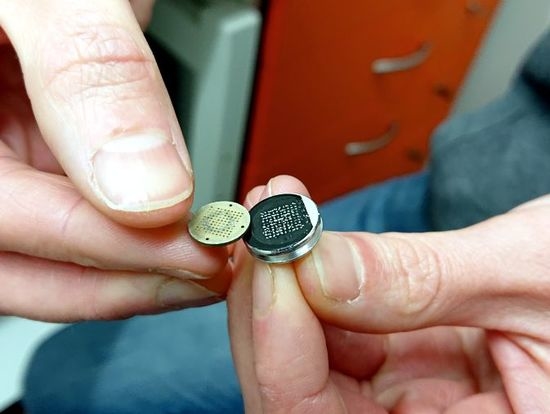Transferring Grains from Single-Grain Luminescence Discs to SEM Specimen Stubs
Abstract
:1. Introduction
2. Experimental Design
2.1. Materials
2.2. Equipment
- Instruments
- ◦
- Risø TL/OSL reader model DA-15 with a single-grain attachment [1] at the luminescence laboratory at the Department of Geography, University of Sheffield, United Kingdom
- ◦
- Tescan Mira3 High Resolution Schottky FE-SEM equipped with Oxford EDS at the Department of Geology, Lund University, Sweden
- ◦
- Stereo Microscope, Zeiss Stemi 2000-C, equipped with a camera, AxioCam ERc 5s, at the Department of Geology, Lund University, Sweden
- Sample holders
- ◦
- Single-grain aluminum discs, 9.7 mm in diameter and 1 mm thick, with one hundred 300 µm holes in a 10 × 10 grid
- ◦
- Specimen mount (stub), aluminum, 1/2” slotted head, 1/8” pin
- Other
- ◦
- Carbon adhesive tabs, 12 mm diameter, Electron Microscopy Sciences
- ◦
- Scissors
- ◦
- Small container, plastic or other material, about 0.5–1 cm higher than the stub height
- ◦
- Styrofoam, thickness about 1 cm (corresponding to height of stub rods)
- ◦
- Tweezers
3. Procedure
3.1. Preparing the Transportation Container
- Find a container of appropriate size with a lid. An appropriate size is one that suits the number of samples and allows a safe transportation of the samples, that is keeping the samples upright.
- Cut a piece of Styrofoam into the desired shape to fit the bottom of the container (Figure 1). Any other flexible but firm material may also be used.
- Prepare holes in the Styrofoam to fit the SEM specimen stubs (Figure 1). Hold the stubs upright (broad side up) and push down the rods into the Styrofoam. If necessary, use a sharp object (for example, a pen) to pierce the holes for the stub rods.
- Mark each hole with a number, for example 1–6 (Figure 1).
3.2. Preparing the SEM Specimen Stubs
- Use scissors to cut the carbon adhesive tabs so that there is one straight side to the previously circular piece.
- Attach the precut tab centered on an SEM specimen stub, and leave the transparent plastic film on (Figure 2).
- Place the stub in the container (Section 3.1) with the rod in one of the holes and the tape side up.
3.3. Transferring Grains from the Single-Grain Disc to the SEM Specimen Stub
- After OSL measurements, take the wheel out of the reader and place it on a stable and horizontal surface.
- Take one of the pre-prepared SEM specimen stubs out of the container and remove the transparent plastic film with tweezers.
- Remember to note the orientation of the holes in the disc and the straight side of the carbon tape.
- Hold the stub on its rod and carefully attach the sticky carbon tape to the SG disc, with the disc still in the wheel. Make sure that the stub is centered and placed with the cut tape side at the “no-hole side” of the SG disc (Figure 2). This enables you to keep track of the orientation, that is to be able to use the numbered grain positions from the reader software. Attention: The grain numbering on the carbon tape is the mirror image of the grains on the SG disc (Figure 3). The grains will also be upside-down compared to the SG disc.
- When the SEM specimen stub is fitted to the SG disc, turn it into an upright position and tap the disc gently with the tweezers.
- Remove the SG disc from the carbon tape using tweezers or your fingernails. You will now be able to see the grains on the carbon tape.
- Place the stub carefully in the container prepared with Styrofoam. The rod should go into one of the rod holes, and the tape side should face upwards.
- Make a note of which sample is in which hole (Figure 4).
- Put the lid on the container, and, if necessary, tape it to keep it in place.
3.4. Transport
Additional Information
4. Results
Author Contributions
Funding
Acknowledgments
Conflicts of Interest
References
- Duller, G.A.T.; Bøtter-Jensen, L.; Kohsiek, P.; Murray, A.S. A high-sensitivity optically stimulated luminescence scanning system for measurement of single sand-sized grains. Radiat. Prot. Dosim. 1999, 84, 325–330. [Google Scholar] [CrossRef]
- Murray, A.S.; Roberts, R.G. Determining the burial time of single grains of quartz using optically stimulated luminescence. Earth Planet. Sci. Lett. 1997, 152, 163–180. [Google Scholar] [CrossRef]
- Duller, G.A.T. Single grain optical dating of glacigenic deposits. Quat. Geochronol. 2006, 1, 296–304. [Google Scholar] [CrossRef]
- Bateman, M.D.; Boulter, C.H.; Carr, A.S.; Frederick, C.D.; Peter, D.; Wilder, M. Detecting post-depositional sediment disturbance in sandy deposits using optical luminescence. Quat. Geochronol. 2007, 2, 57–64. [Google Scholar] [CrossRef]
- Duller, G.A.T. Single-grain optical dating of quaternary sediments: Why aliquot size matters in luminescence dating. Boreas 2008, 37, 589–612. [Google Scholar] [CrossRef]
- Duller, G.A.T.; Bøtter-Jensen, L.; Murray, A.S. Optical dating of single sand-sized grains of quartz: Sources of variability. Radiat. Meas. 2000, 32, 453–457. [Google Scholar] [CrossRef]
- Bailey, R.M.; Arnold, L.J. Statistical modelling of single grain quartz De distributions and an assessment of procedures for estimating burial dose. Quat. Sci. Rev. 2006, 25, 2475–2502. [Google Scholar] [CrossRef]
- Rhodes, E. Quartz single grain OSL sensitivity distributions: Implications for multiple grain single aliquot dating. Geochronometria 2007, 26, 19–29. [Google Scholar] [CrossRef]
- Alexanderson, H.; Bernhardson, M. Late glacial and Holocene sand drift in south-central Sweden. GFF 2019, 141, 84–105. [Google Scholar] [CrossRef]
- Sigfúsdóttir, T. A Sedimentological and Stratigraphical Study of Veiki Moraine in Northernmost Sweden; Lund University: Lund, Sweden, 2013. [Google Scholar]
- Alexanderson, H.; Bernhardson, M. OSL dating and luminescence characteristics of aeolian deposits and their source material in Dalarna, central Sweden. Boreas 2016, 45, 876–893. [Google Scholar] [CrossRef]
- Anjar, J.; Alexanderson, H.; Larsen, E.; Lyså, A. OSL dating of Weichselian ice-free periods at Skorgenes, Western Norway. Nor. J. Geol. 2018, 98, 301–313. [Google Scholar] [CrossRef]
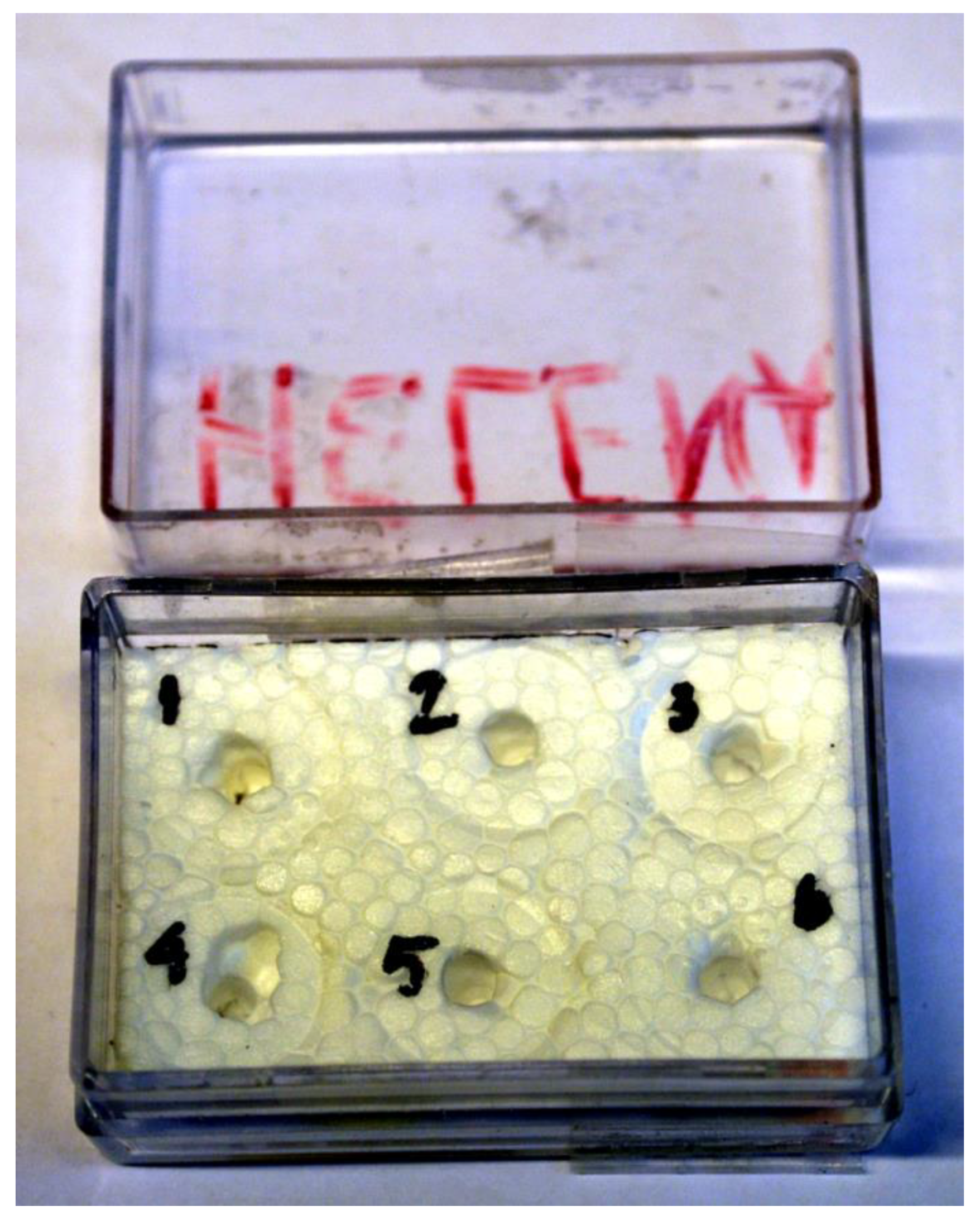
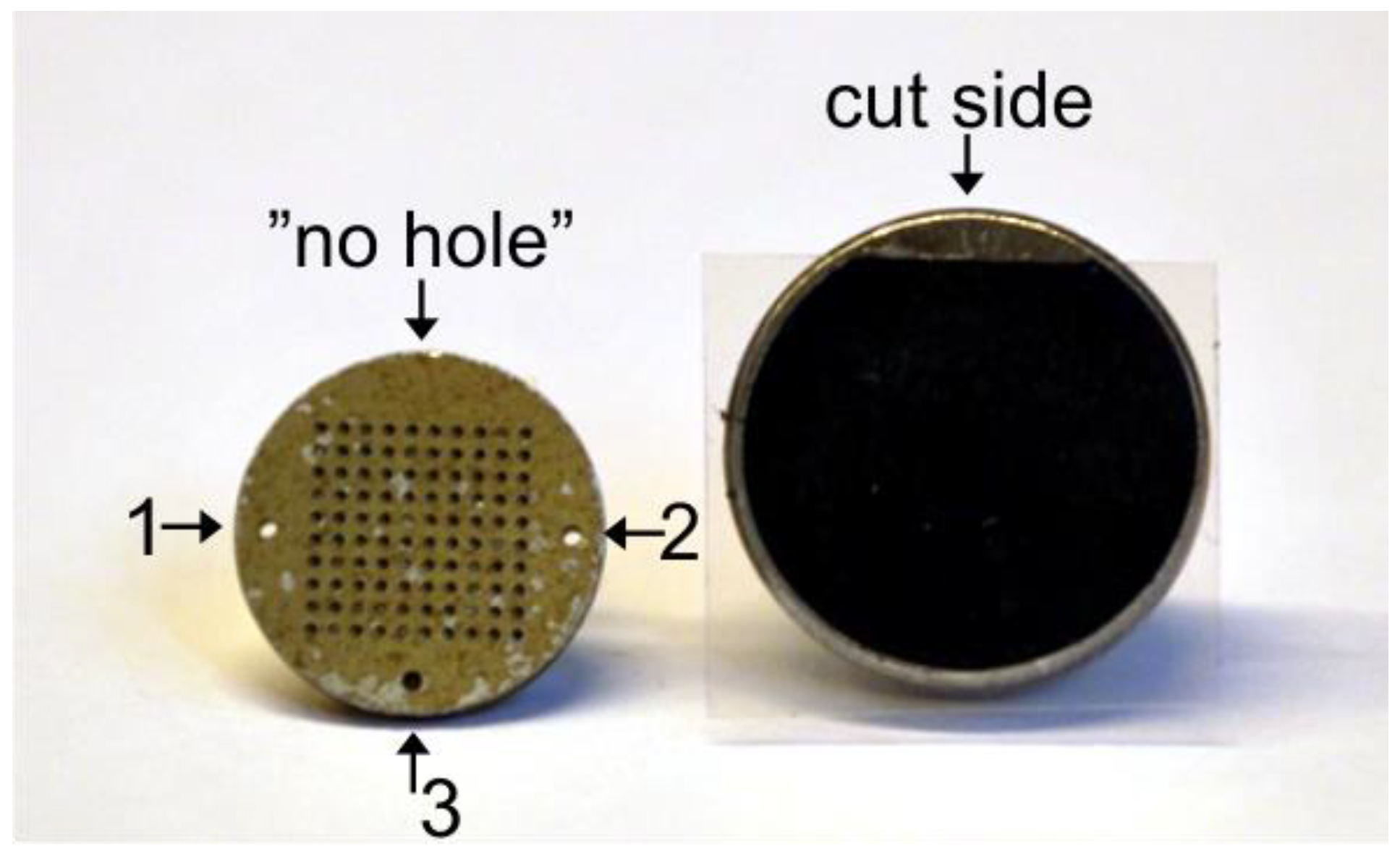
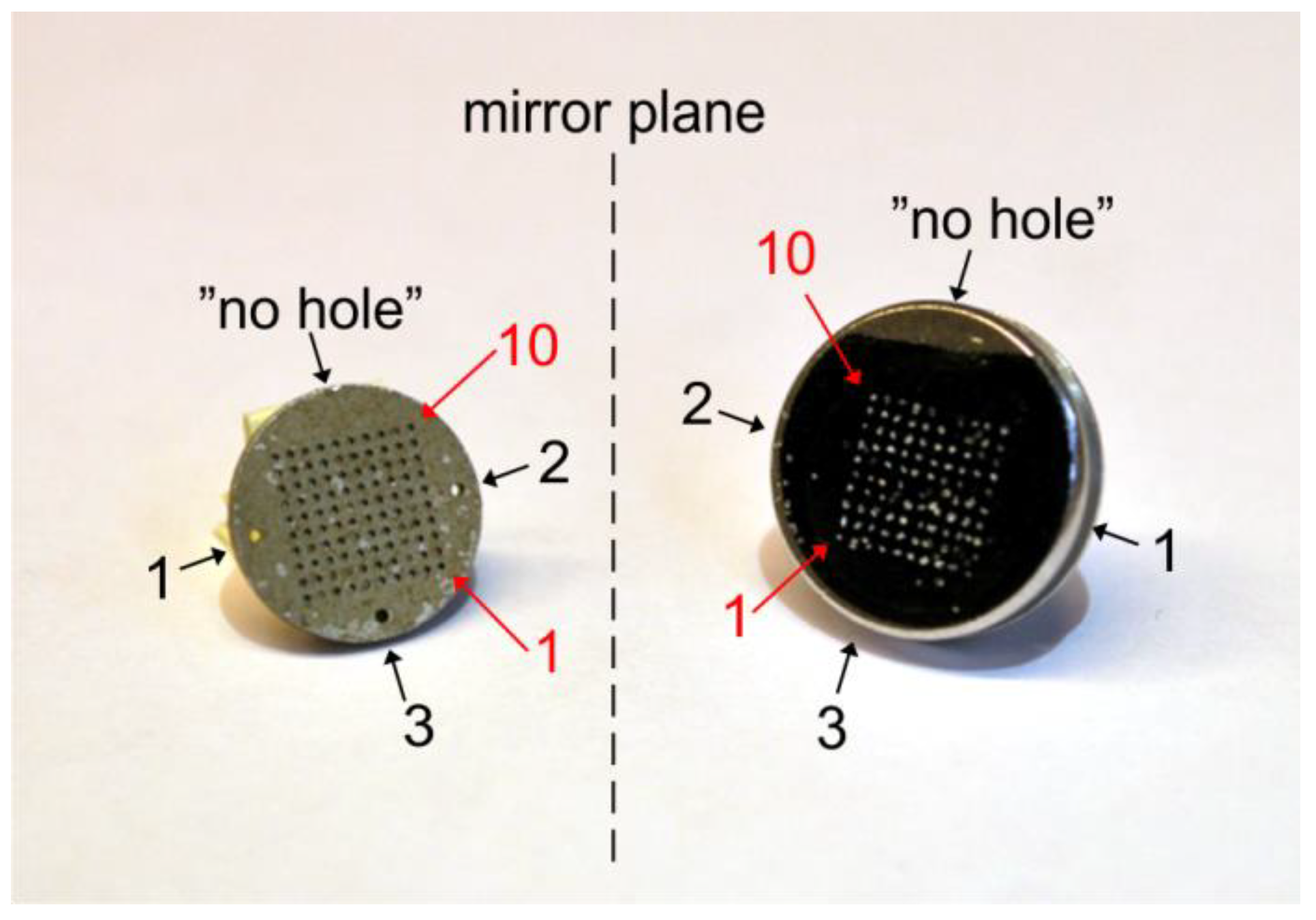
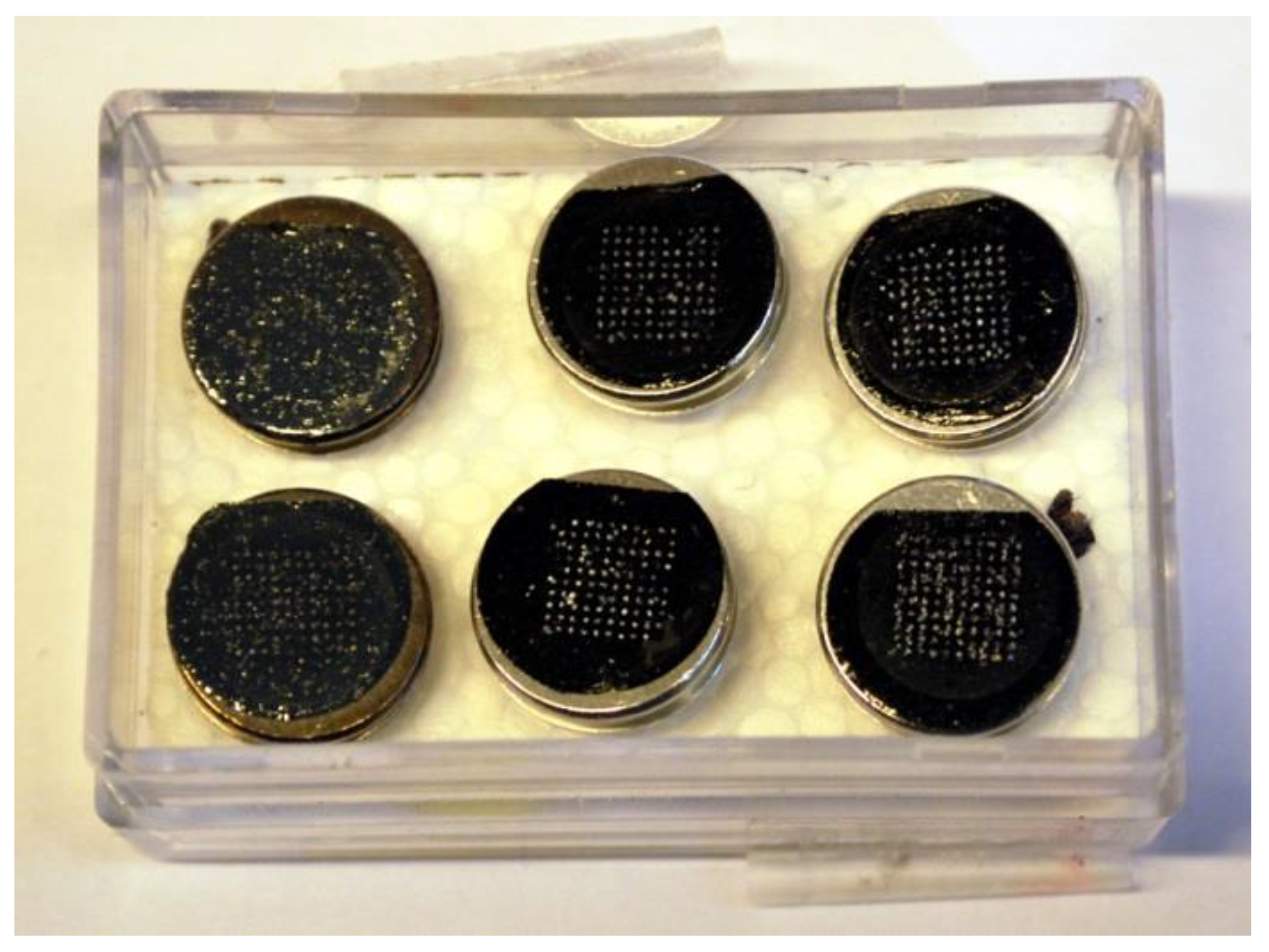
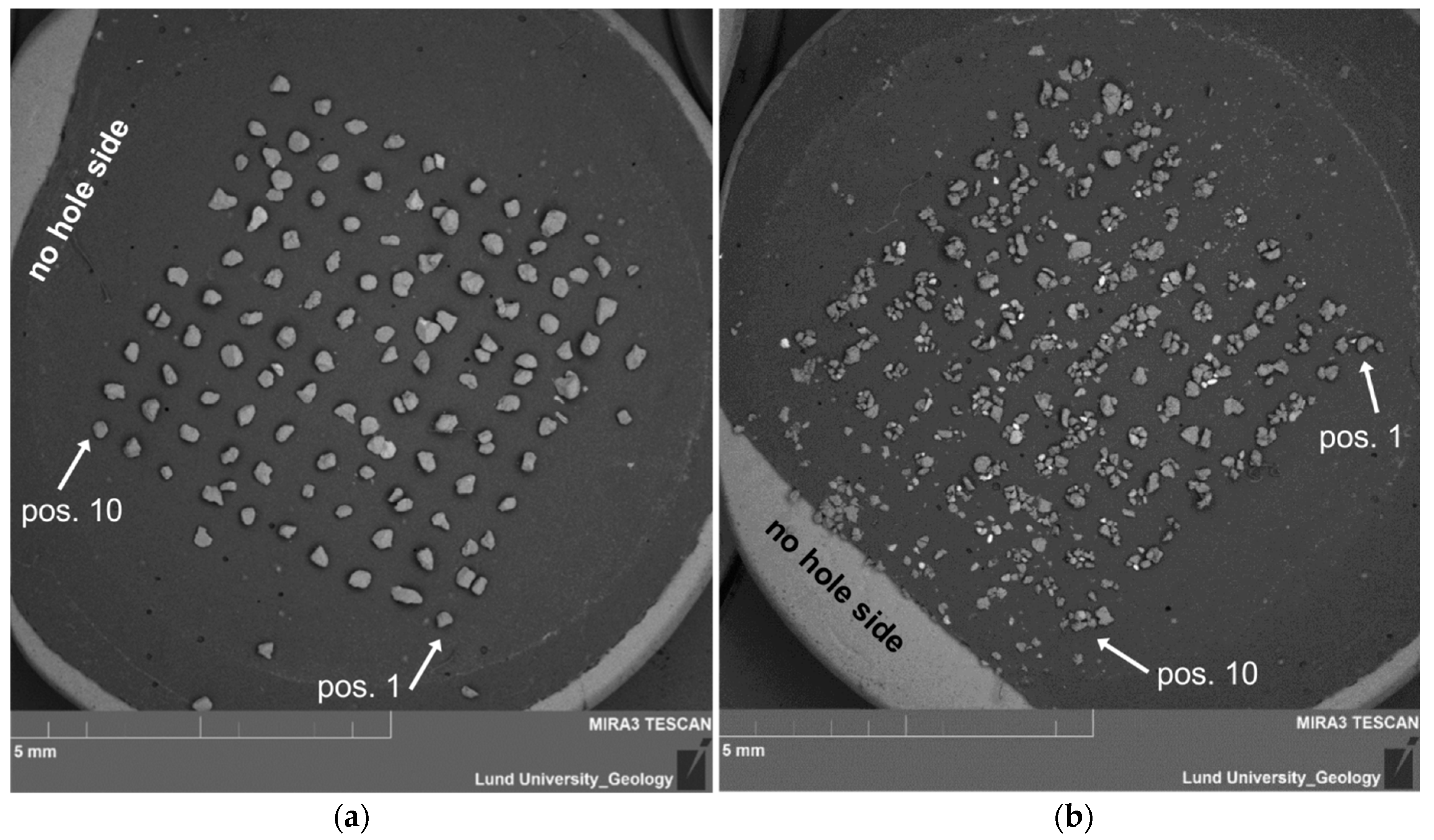
| Lab. No Lund- | Site | Sediment | Disc | Reference |
|---|---|---|---|---|
| 12057 | Rauvospakka, N Sweden | glacilacustrine silty sand | 4, 5 | [10] |
| 13031 | Orsa, C Sweden | aeolian sand | 1, 7, 8, 9 | [11] |
| 15012 | Skorgenes, W Norway | glacifluvial sand | 6 | [12] |
| 15064 | Skogalund, SW Sweden | aeolian sand | 2, 3 | [9] |
| Disc | #Filled Positions on Disc | #Filled Positions on Stub | Transfer Success (%) |
|---|---|---|---|
| 1 | 100 | 90 | 90.0 |
| 2 | 97 | 98 1 | 101.0 1 |
| 3 | 100 | 97 | 97.0 |
| 4 | 99 | 90 | 90.9 |
| 5 | 100 | 93 | 93.0 |
| 6 | 100 | 100 2 | 100.0 2 |
| 7 | 98 | 96 | 98.0 |
| 8 | 100 | 95 | 95.0 |
| 9 | 100 | 83 3 | 83 3 |
© 2019 by the authors. Licensee MDPI, Basel, Switzerland. This article is an open access article distributed under the terms and conditions of the Creative Commons Attribution (CC BY) license (http://creativecommons.org/licenses/by/4.0/).
Share and Cite
Doverbratt, I.; Alexanderson, H. Transferring Grains from Single-Grain Luminescence Discs to SEM Specimen Stubs. Methods Protoc. 2019, 2, 87. https://doi.org/10.3390/mps2040087
Doverbratt I, Alexanderson H. Transferring Grains from Single-Grain Luminescence Discs to SEM Specimen Stubs. Methods and Protocols. 2019; 2(4):87. https://doi.org/10.3390/mps2040087
Chicago/Turabian StyleDoverbratt, Isa, and Helena Alexanderson. 2019. "Transferring Grains from Single-Grain Luminescence Discs to SEM Specimen Stubs" Methods and Protocols 2, no. 4: 87. https://doi.org/10.3390/mps2040087
APA StyleDoverbratt, I., & Alexanderson, H. (2019). Transferring Grains from Single-Grain Luminescence Discs to SEM Specimen Stubs. Methods and Protocols, 2(4), 87. https://doi.org/10.3390/mps2040087




